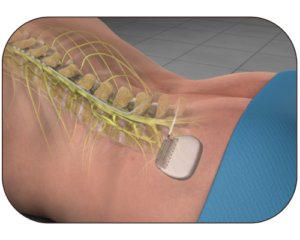
Welcome to Dr. Murali’s Pain Centre, where we specialize in delivering relief and improving the quality of life for individuals suffering from chronic pain. With a commitment to compassionate care and cutting-edge treatments, our dedicated team led by Dr. Murali is here to empower you on your journey towards a pain-free and fulfilling life.

What is spinal cord stimulation?
Spinal cord stimulation (SCS) is a medical procedure that uses electrical impulses to treat chronic pain, especially in cases where other conservative pain management methods have proven ineffective. During spinal cord stimulation, a small device, known as a spinal cord stimulator or neurostimulator, is implanted near the spine, and it delivers mild electrical signals to the spinal cord. These electrical signals interfere with or block the pain signals that are being transmitted to the brain, resulting in a reduction in pain perception. Spinal cord stimulation is often used to manage chronic pain conditions such as failed back surgery syndrome, complex regional pain syndrome (CRPS), and neuropathic pain.
Indications
- Back pain, especially back pain that continues even after surgery (failed back surgery syndrome)
- Post-surgical pain
- Arachnoiditis (painful inflammation of the arachnoid, a thin membrane that covers the brain and spinal cord)
- Heart pain (angina) untreatable by other means
- Injuries to the spinal cord
- Nerve-related pain (such as severe diabetic neuropathy and cancer-related neuropathy from radiation, surgery or chemotherapy)
- Peripheral vascular disease
- Complex regional pain syndrome
- Pain after an amputation
- Visceral abdominal pain and perineal pain
Contraindications
Injections are generally avoided in patients who have a systemic illness or skin infection over the puncture site, bleeding problems or coagulopathy, or an allergy to local anaesthetics or any of the drugs that will be administered.
Complications
- Infection, which may occur in the first 2-8 weeks.
- Bleeding.
- Device migration (i.e., the electrodes move from their original location and the stimulator doesn’t block pain as effectively). This often requires a follow-up surgery to put the electrodes back in the proper spot.
- Device damage (e.g., a fall or intense physical activity breaks the stimulator).
- Dural puncture.
Post Procedure
Your doctor will discuss your recovery plan, but generally lighter activity is recommended for about 2 weeks after surgery. Once your Doctor approves you for regular activity, you can return to work and drive again (with the stimulator turned off). This is typically 1-2 weeks after surgery.
